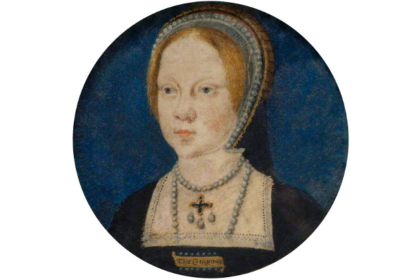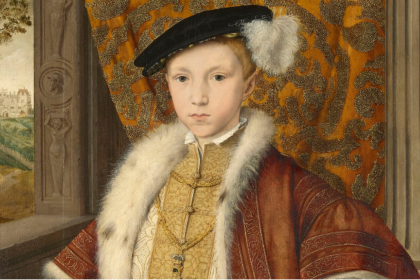Early in February, I made a post on a poem composed by Richard Edwardes, about the ladies who served Mary I, which you can read here. In my research for that post, I came across a reference to a similar poem written about the ladies who served Elizabeth, entitled ‘The prayse of six gentle Women attending of the Ladye Elizabeth her grace at Hatfield then.’
This poem was written by John Harington, a Tudor politician and writer, who lived 1517–1582. He was favoured by Elizabeth I, who stood as godmother to his son, John. Elizabeth and Harington first became acquainted some time prior to her ascension, perhaps when he served in the household of Thomas Seymour, whose imprisonment he shared though fortunately survived. They certainly knew each other in Mary’s reign; he was accused of delivering a letter to Elizabeth in connection with the Wyatt plot, for which both he and Elizabeth were imprisoned. Early in Elizabeth’s reign, Harington married Isabel Markham, one of the ladies who had loyally served her prior to her queenship. Markham had been the object of the already married Harington’s affections for some years, and she appears in this poem as being worthy of the gift of a phoenix.
Little is known about this poem. There have been next to no attempts to analyse it, nor to identify the women listed, who Harington only gives by surname. The title seems to suggest that it was written before Elizabeth became queen; however, I believe that the poem was written during the first year of Elizabeth’s reign, and that the title was an addition made at some point in the centuries since.
The poem certainly refers to Elizabeth’s time as Hatfield prior to her reign, perhaps even the time of ascension since the narrator is ‘commaunded in haste to Hatfield,’ where Elizabeth was residing at the time. There are several points which suggest that it could have been written at a later time. Firstly, for a man already suspected of being involved in a rebellion in Elizabeth’s name, it would seem quite foolish to write a poem in praise of her and her household. Elizabeth was in disgrace during this period; the smart man praised Queen Mary. Furthermore, the stanza on Markham I believe suggests that she was at least betrothed to Harington, if not married: ‘Oh, happie twyse is hee/whome love shall do the grace/to lynck in vnytie/that blissfull to enbrace’; as well as the comparing her to Griselda, the epitome of long-suffering, uncomplaining wifehood. Finally, I believe that my identifications of the ladies only make sense in the context of Queen Elizabeth’s royal court.
I believe the first lady mentioned ‘Grey’ is Katherine Grey, rather than her sister Mary Grey. Katherine never served Elizabeth prior to her queenship, but after her ascension, Katherine was made a Maid of Honour. Katherine was also the next in line for the throne under the terms of Henry VIII’s Act of Succession. That status would also explain why she is placed first in the poem. Katherine married Edward Seymour, Earl of Hertford, without consent in 1560, and was imprisoned for the rest of her life. This suggests the poem was written in the first couple of years of Elizabeth’s reign.

The next lady mentioned is Willobe, who can be identified as Margaret Willoughby, who did actually serve Lady Elizabeth prior to her ascension. Upon becoming queen, Elizabeth made Margaret a Gentlewoman of the Privy Chamber. On the 5th October, 1559, just under a year after Elizabeth’s ascension, Margaret married and became Mrs. Arrundel. Therefore, the poem must have been written within the first year of Elizabeth’s reign, otherwise she would have been named Arrundel by Harington.
Markham, of course, we have already discussed, refers to Isabel Markham, who would become Harington’s wife, again, within the first year of Elizabeth’s reign. Along with Margaret Willoughby, she served Elizabeth at Hatfield. Upon Elizabeth’s ascension, Markham became a Gentlewoman of the Privy Chamber.
Norwyche is Elizabeth Norwyche, who was a Gentlewoman of the Bedchamber to Queen Elizabeth. She did serve Elizabeth prior to her ascension. She became Lady Carew upon her marriage to Sir Gawain Carew in 1562.
Seintloe is most likely to be one Elizabeth St. Loe. Though there is no evidence that she served Elizabeth prior to ascension, her brother did serve Elizabeth at Hatfield. St. Loe became a Gentlewoman of the Privy Chamber upon Elizabeth’s ascension.
Skypwith would be Bridget Skipwith, who is listed as a Gentlewoman of the Privy Chamber to Elizabeth in 1559, and attended Elizabeth at her coronation. There is no evidence that Skipwith served Elizabeth prior to this. She married in 1567 and became known as Mrs Cave.
All of these ladies attended Elizabeth at her coronation on the 15th January, 1559. Whilst half of them did have a history of serving Elizabeth prior to her ascension, there is no evidence that Bridget Skipwith or Elizabeth St. Loe did; Katherine Grey certainly did not. I believe that Harington wrote the poem shortly after the coronation, and is describing the narrator attending Hatfield shortly after Elizabeth’s ascension, which is in essence being compared with Diana’s bounty. The title must have been added by a later individual who assumed the poem was written whilst Elizabeth was still living at Hatfield.
~
The prayse of six gentle Women attending of the Ladye Elizabeth her grace at Hatfield then
The great Dyana, chaste
infforest late I mett
who me commaunded in haste
to Hatfield for to geatt
And to you Sixe a rowe
her pleasure to declare
How she meanes to bestow
on eache a gift most rare
~
ffyrst doth she geve to Grey
the ffawlcons Curtesse kinde
her Lord for to obay
with moste obedient mynde
ffraught with suche vertues rare
his love aye to renew
with Tysbe to compare
Or , Alsyon most trew
~
To worthye willobe
As Egle in her flight
So shall her pearcing eye
bothe heale and hurt eache wight
that shall vppon her gase
Shall sone perceyve I see
A Lawra, in her face
And not a Willobe
~
To Markhams, modest mynde
that Phenixe bird most rare
So have the godes assynde
with Grysylde to compare
Oh , happie twyse is hee
whome love shall do the grace
to lynck in vnytie
that blissfull to enbrace
~
To Norwyche good and grave
Suche Sapient eares is send
As prudent Serpents have
the Charmer to defend
with knowledge in foresight
of suche thinges yet to come
As had Cassandra bright
Whoe tolde of Troye the dome
~
ffor Seintloe doth she say
So stable shall shee stand
as rock within the sea
or hudge hill on the land
dye rather with the mace
ffrom mightie Hercules hand
then once her truth degrace
yf she theare in do stand
~
If Skypwith shuld escape
Without her gift most rare
Dyana wold me hate
and fill my life with care
syns in her Temple chaste
full highe vppon the wall
her bowe thear hangith fast
vnbroke and ever shall
~
Thus have I shewid you all
this worthie goddesse will
Who hath decreed you shall
as her owne ympps lyve still
long in suche sacred sort
whearof dame fame shall bloe
suche trumppe of true reporte
as through the earth shall goe
ffin
~
Top image: Coronation portrait of Elizabeth I, c.1600, from a lost original





